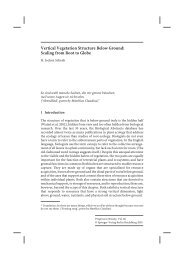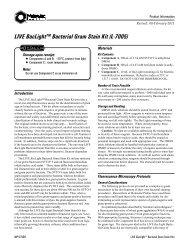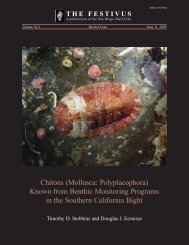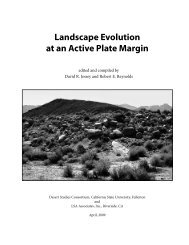2010 Overboard in the Mojave - Biological Science - California State ...
2010 Overboard in the Mojave - Biological Science - California State ...
2010 Overboard in the Mojave - Biological Science - California State ...
You also want an ePaper? Increase the reach of your titles
YUMPU automatically turns print PDFs into web optimized ePapers that Google loves.
of borate m<strong>in</strong>erals dur<strong>in</strong>g <strong>the</strong> very<br />
early 20th century and ru<strong>in</strong>s of<br />
m<strong>in</strong>es, railroads, and dwell<strong>in</strong>gs<br />
testify to <strong>the</strong> importance of <strong>the</strong><br />
m<strong>in</strong><strong>in</strong>g <strong>in</strong>dustry at this location.<br />
CONVENE at <strong>the</strong> Desert Studies<br />
Center with a full tank of gas. Enter<br />
westbound I-15 toward M<strong>in</strong>neola<br />
Road.<br />
0.0 (0.0) EXIT at M<strong>in</strong>neola Road.<br />
Re-set odometer.<br />
0.3 (0.3) Stop at M<strong>in</strong>neola Road.<br />
TURN RIGHT (north). The road<br />
will bear east.<br />
0.9 (0.6) Cont<strong>in</strong>ue past a left<br />
turn to <strong>the</strong> landfill and <strong>the</strong> Calico<br />
Mounta<strong>in</strong>s Archaeological Site .<br />
1.1 (0.2) BEAR RIGHT. When<br />
pavement ends, take <strong>the</strong> middle<br />
power l<strong>in</strong>e access road and bear<br />
nor<strong>the</strong>ast.<br />
1.3 (0.2) Avoid <strong>the</strong> left turn.<br />
1.4 (0.1) BEAR LEFT on power l<strong>in</strong>e road.<br />
2.3 (0.9) STOP M-5—Toomey Hills. PARK <strong>in</strong> open<br />
area north of road. The Barstow Formation is exposed on<br />
<strong>the</strong> north side of <strong>the</strong> Manix fault, as it is at Harvard Hill.<br />
Near <strong>the</strong> base of <strong>the</strong> section are fluvial gravels with wellrounded<br />
clasts and tubular stromatolites (CRC, Reynolds<br />
and o<strong>the</strong>rs, this volume) <strong>in</strong> a section of sandstone cemented<br />
by calcite. Above are f<strong>in</strong>e-gra<strong>in</strong>ed lacustr<strong>in</strong>e sandy<br />
silt beds <strong>in</strong>terlaced with tuffs. This outcrop produced fossil<br />
mammals which document <strong>the</strong> 16 Ma transition from<br />
<strong>the</strong> Hem<strong>in</strong>gfordian to Barstovian NALMA (Woodburne,<br />
1991; Woodburne and Reynolds, this volume; Tedford<br />
and o<strong>the</strong>rs, 2004). A local sequence of beds (CRC,<br />
Emerald Tuff, Lime Tuff) allow <strong>the</strong> Toomey sequence to<br />
be correlated with a datable section <strong>in</strong> <strong>the</strong> Yermo Hills to<br />
<strong>the</strong> northwest (Miller and o<strong>the</strong>rs this volume). The crest<br />
of <strong>the</strong> ridge here is a thick, strongly cemented soil, above<br />
which is <strong>the</strong> Pliocene–Pleistocene Yermo Gravel. RE-<br />
TRACE toward M<strong>in</strong>neola Road.<br />
3.6 (1.3) TURN RIGHT (north) at road to <strong>the</strong> county<br />
landfill and Calico Mounta<strong>in</strong>s Archaeological Site.<br />
4.8 (1.2) TURN LEFT (west) away from entrance to <strong>the</strong><br />
Calico site and landfill.<br />
5.6 (0.8) TURN RIGHT (north) <strong>in</strong>to Emerald Bas<strong>in</strong>.<br />
r. e. reynolds and d. m. mller<br />
Stop M-6. Yermo Hills, show<strong>in</strong>g lime-green sandstone and 15.3 Ma ash layer.<br />
6.0 (0.3) PARK <strong>in</strong> open area, avoid<strong>in</strong>g nails from burnt<br />
wood.<br />
STOP M-6—Overview of Emerald Bas<strong>in</strong> <strong>in</strong> <strong>the</strong> Yermo<br />
Hills. This section conta<strong>in</strong>s a sequence of beds (CRC,<br />
Emerald Tuff, Lime Tuff) similar to <strong>the</strong> Toomey Hills.<br />
A dated tuff near <strong>the</strong> top of <strong>the</strong> section is about 15.3<br />
Ma (Miller and o<strong>the</strong>rs, this volume). If <strong>the</strong> CRC here is<br />
equivalent to <strong>the</strong> CRC at <strong>the</strong> 16+ Ma Toomey Hills stop,<br />
<strong>the</strong>n <strong>the</strong> gray siltstone section represents at least 0.7 Ma.<br />
A thick, silicified limestone on <strong>the</strong> ridge l<strong>in</strong>e can be traced<br />
westward <strong>in</strong>to <strong>the</strong> eastern Calico Mounta<strong>in</strong>s where it<br />
overlies <strong>the</strong> 16.2+ Ma BPL. Retrace to ma<strong>in</strong> dirt road and<br />
proceed northwest.<br />
6.1 (0.2) TURN RIGHT (northwest) onto ma<strong>in</strong> dirt<br />
road and proceed northwest.<br />
7.0 (0.9) Jo<strong>in</strong> <strong>the</strong> pole l<strong>in</strong>e road and proceed north. This<br />
road co<strong>in</strong>cides with <strong>the</strong> approximate position of <strong>the</strong><br />
north-trend<strong>in</strong>g T<strong>in</strong> Can Alley fault, described and named<br />
by Dudash (2006). It is a right-lateral fault that <strong>in</strong> places<br />
exhibits scarps cutt<strong>in</strong>g Holocene materials.<br />
7.2 (0.2) TURN LEFT (west) onto Mule Canyon Road.<br />
8.3 (1.1) Cont<strong>in</strong>ue past <strong>the</strong> Sulfur Hole quarry <strong>in</strong> <strong>the</strong><br />
BPL which produced an unusual assemblage of hydrous<br />
iron sulfate m<strong>in</strong>erals oxide products from pyrite deposited<br />
by hot spr<strong>in</strong>gs (Dunn<strong>in</strong>g and Copper, 2002; Schuil<strong>in</strong>g,<br />
1999).<br />
14 <strong>2010</strong> Desert Symposium
















